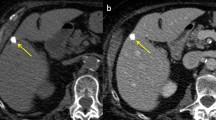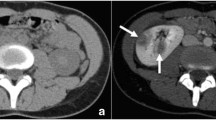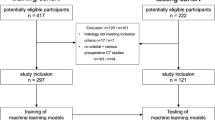Abstract
Almost all kidney stones are CT positive. Before a CT scan can be done a CT planning image (CTI) is generated in order to select the exact scanning area. The CTI looks approximately like a normal kidney–ureter–bladder abdominal radiography (KUB) but with reduced quality. It has been used as a guide, assuming that if the kidney stone could be seen on the CTI the kidney stone also would be visible on a conventional plain KUB (radiopaque). From the perspective of diagnosis and treatment as well as follow-up it is of importance to know whether a kidney stone is radiopaque or not. The aim of this study was to evaluate whether the CTI actually can predict radiopacity. CT scans and corresponding KUB’s were analysed in 76 consecutive kidney stone patients. The CT scan and the KUB were performed on the same day. All patients were examined with the same CT scanner (64 slice GE light speed VCT). Three radiologists evaluated the images in plenum. The following was recorded regarding the kidney stones: X-ray positive (radiopaque on KUB), CTI positive (radiopaque on CTI), location (a kidney, b upper two-thirds of ureter and c lower one-thirds of ureter including the bladder), size and Hounsfield units (HU). We also measured the patient’s ‘anterior–posterior depth’ (APD) at the kidney stone level in axial plane, and whether the stone was homogeneous/inhomogeneous. 54 of the 76 patients (71%) had radiopaque stones on KUB. 43 (57%) of these also could be seen on the CTI, resulting in a positive predicting value (PPV) of 100% and a negative predictive value (NPV) of 67%. In the 54 KUB positive kidney stones the mean kidney stone diameter was 7 mm (2–30 mm), mean HU’s 1,007 (294–1,782 HU), location: a:32, b:9 and c:13 patients. APD was mean 23.6 cm (13–39 cm). In the KUB positive and CTI negative kidney stones (11 patients) mean kidney stone diameter was 4 mm (2–9 mm), mean HU’s 742 (294–1,253 HU), location: a:32, b:9 and c:13 patients. APD in this group was mean 26.1 cm (13–37 cm). If the kidney stone can be seen on the CTI it is also visible on a plain KUB (PPV 100%). The CTI do, however, underestimate the radiopacity of a stone on a plain KUB (NPV 67%). Kidney stone HU > 742, stone location in the kidney and proximal ureter and APD < 26 cm independently predict agreement between CTI and KUB with regard to radiopacity.




Similar content being viewed by others
Abbreviations
- NCHCT:
-
Non-contrast helical CT
- KUB:
-
Kidney–ureter–bladder abdominal radiography
- CTI:
-
CT planning image
- APD:
-
Patient’s anterior–posterior depth
- HU:
-
Hounsfield units
- PACS:
-
Picture archiving communication system
- mSv:
-
Milli sieverts
- mA:
-
Milli ampere
References
Smith RC, Coll DM (2000) Helical computed tomography in the diagnosis of ureteric colic. BJU Int 86(Suppl):133–141
Norlin A, Lindell B, Granberg PO (1976) Urolithiasis. A study of its frequency. Scand J Urol Nephrol 10:150–153
Johnson CM, Wilson DM, O’Fallon WM, Malek RS, Kurland LT (1979) Renal stone epidemiology: a 25-year study in Rochester, Minnesota. Kidney Int 16(5):624–631
Dalrymple NC, Verga M, Anderson KR, Bove P, Covey a M, Rosenfield a T et al (1998) The value of unenhanced helical computerized tomography in the management of acute flank pain. J Urol 159(3):735–740
Jackman SV, Potter SR, Regan F, Jarrett TW (2000) Plain abdominal X-ray versus computerized tomography screening: sensitivity for stone localization after nonenhanced spiral computerized tomography. J Urol 164(2):308–310
Chu G, Rosenfield AT, Anderson K, Scout L, Smith R (1999) Sensitivity and value of digital CT scout radiography for detecting ureteral stones in patients with ureterolithiasis diagnosed on unenhanced CT. AJR Am J Roentgenol 173(2):417–423
Assi Z, Platt JF, Francis IR, Cohan RH, Korobkin M (2000) Sensitivity of CT scout radiography and abdominal radiography for revealing ureteral calculi on helical CT: implications for radiologic follow-up. AJR Am J Roentgenol 175(2):333–337
Ege G, Akman H, Kuzucu K, Yildiz S (2004) Can computed tomography scout radiography replace plain film in the evaluation of patients with acute urinary tract colic? Acta Radiol 45(4):469–473
Johnston R, Lin A, Du J, Mark S (2009) Comparison of kidney-ureter-bladder abdominal radiography and computed tomography scout films for identifying renal calculi. BJU Int 104(5):670–673
Saw KC, McAteer JA, Fineberg NS, Monga a G, Chua GT, Lingeman JE et al (2000) Calcium stone fragility is predicted by helical CT attenuation values. J Endourol 14(6):471–474
Zilberman DE, Ferrandino MN, Preminger GM, Paulson EK, Lipkin ME, Boll DT (2010) In vivo determination of urinary stone composition using dual energy computerized tomography with advanced post-acquisition processing. J Urol 184(6):2354–2359
Radiological Society of North America. Safety in medical imaging procedures. available at: http://www.radiologyinfo.org
Berrington de González A, Mahesh M, Kim KP, Bhargavan M, Lewis R, Mettler F et al (2009) Projected cancer risks from computed tomographic scans performed in the United States in 2007. Arch Intern Med 169(22):2071–2077
Author information
Authors and Affiliations
Corresponding author
Rights and permissions
About this article
Cite this article
Graumann, O., Osther, S.S., Spasojevic, D. et al. Can the CT planning image determine whether a kidney stone is radiopaque on a plain KUB?. Urol Res 40, 333–337 (2012). https://doi.org/10.1007/s00240-011-0411-9
Received:
Accepted:
Published:
Issue Date:
DOI: https://doi.org/10.1007/s00240-011-0411-9




